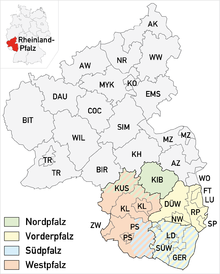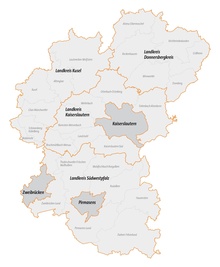West Palatinate
The West Palatinate is a sub-region in the west of the Rhineland-Palatinate region Palatinate and takes (depending on the delimitation) about a third of it. It comprises the western part of the Palatinate Forest , the central part of the North Palatinate Uplands , the West Palatinate Moorniederung and the Westrich plateau . An earlier name was "Hinterpfalz". It dates back to the time of the Bavarian administration from 1816 and is nowadays sometimes perceived as discriminatory by the residents themselves.
geography
The following districts and urban districts are wholly or partially in the West Palatinate:
- District of Kaiserslautern
- City of Kaiserslautern
- District of Kusel
- City of Pirmasens
- Southwest Palatinate district
- City of Zweibrücken
- Donnersbergkreis
The Donnersbergkreis or the Altkreise Rockenhausen and Kirchheimbolanden are mostly viewed as an independent region ( Northern Palatinate ).
A different definition also exists for the classification of the police; In addition to the districts listed above, the West Palatinate Police Headquarters only looks after the western part of the Donnersbergkreis (roughly equivalent to the old Rockenhausen district) and the Meisenheim community in the Bad Kreuznach district.
Historically, the Saar- Palatinate District was also part of the Western Palatinate until 1920 .
history
The West Palatinate has been settled since the Neolithic Age, barrows from the bronze and Celtic ramparts from the Iron Age are visible evidence of this. Around 500 years of Roman presence followed, documented by the remains of Roman roads and settlements to this day. The Staufer era left behind many castles in the Palatinate, including the Kaiserpfalz , which Emperor Friedrich Barbarossa had built in Kaiserslautern in 1158. During the Thirty Years War (1618-1648) the region was a theater of war several times. Large stretches of land, innumerable places and numerous castles were destroyed. 40 years later, the Palatinate War of Succession again led to the destruction of large parts of the Palatinate. Escaping the misery and hunger, the first people from the region emigrated to America in 1709. Industrialization got under way in the second half of the 18th century and gained significant momentum in the middle of the 19th century, including the construction of the railway connection from the Saar area to Ludwigshafen. The worsted spinning mill and the Pfaff sewing machine factory were established in Kaiserslautern, and the shoe industry in the south-west Palatinate around Pirmasens. At the end of the 18th and the beginning of the 19th century, the region was under French rule, went to Bavaria following resolutions by the Congress of Vienna in 1816 and was part of the newly founded German Empire since 1871. The time after the Second World War - which was associated with severe damage - was characterized by the strong presence of American, but also French and Canadian armed forces. After the end of the Cold War, this was significantly reduced. The greater Kaiserslautern area, with the Ramstein airfield , the Landstuhl military hospital and numerous depots and barracks, is still one of the most important locations for the US military and NATO in Europe.
population
Almost 550,000 people live in the West Palatinate, including around 30,000 foreigners. In addition, there are around 50,000 Americans living in the greater Kaiserslautern area who are not included in the official population statistics. They form the largest American community outside the United States. By far the largest city and the regional center is Kaiserslautern with around 102,000 inhabitants, followed by Pirmasens and Zweibrücken.
| city |
status |
circle |
Population (December 31, 2017) |
|---|---|---|---|
| Kaiserslautern | Upper center | circular | 100,747 |
| Pirmasens | Middle center | circular | 40,707 |
| Zweibrücken | Middle center | circular | 34,275 |
| Eisenberg (Palatinate) | Middle center | Donnersbergkreis | 9,311 |
| Landstuhl | Middle center | Kaiserslautern | 8,811 |
| Kirchheimbolanden | Middle center | Donnersbergkreis | 7,815 |
| Bruchmühlbach-Miesau | Middle center | Kaiserslautern | 7,720 |
| Ramstein-Miesenbach | Middle center | Kaiserslautern | 7,543 |
| Enkenbach-Alsenborn | Middle center | Kaiserslautern | 6,959 |
| Rodalben | Middle center | Southwest Palatinate | 6,952 |
| Schönenberg-Kübelberg | Middle center | Kusel | 5,543 |
| Rockenhausen | Middle center | Donnersbergkreis | 5,322 |
| Otterberg | Basic center | Kaiserslautern | 5,274 |
| Kusel | Middle center | Kusel | 4,992 |
| Waldfischbach castle albums | Middle center | Southwest Palatinate | 4,786 |
| Dahn | Middle center | Southwest Palatinate | 4,595 |
Culture and leisure
The cultural center of the region is Kaiserslautern with the Pfalztheater (music theater, drama, ballet), the Pfalzgalerie (art exhibitions), the Fruchthalle (classical concerts), the Kammgarn cultural center and other cultural institutions as well as a diverse pub and restaurant scene that is noticeably influenced by the strong American presence and over 13,000 students.
Numerous castles, including Lichtenberg Castle near Kusel, attract visitors, as do extraordinary museums, e.g. B. the interactive museum Dynamikum in Pirmasens.
A point of attraction for people from southwest Germany, Luxembourg and northern France is the Zweibrücken Fashion Outlet in Zweibrücken, the largest outlet center in Germany with 120 shops and over 3 million visitors.
The region's outstanding recreational value, however, is nature, which enables a wide range of activities. The Palatinate Forest and the Donnersberg are popular hiking areas and also offer mountain bikers and racing cyclists excellent conditions. The Dahner Felsenland is one of the most popular climbing areas in Germany.
Economy and Transport
economy
The West Palatinate region has been in a profound economic structural change for decades. Traditional focal points, such as the shoe industry in Pirmasens and the textile industry in Kaiserslautern, have lost a lot of their importance in the past decades, without, however, completely losing them. Through the settlement of research institutes and high-tech companies in the vicinity of the Technical University of Kaiserslautern , positive impulses have been set in recent years and the Kaiserslautern region has been established as an important IT location. The city of Kaiserslautern therefore also calls itself “Silicon Woods”, based on the well-known “Silicon Valley” in California.
Numerous successful medium-sized companies, especially mechanical engineers and automotive suppliers, form the backbone of the regional economy. Due to the close ties with the US, several US corporations, e. B. the agricultural machinery manufacturer John Deere , production and development facilities are located in the region.
science
The region is home to the Technical University of Kaiserslautern and the University of Kaiserslautern (with branches in Zweibrücken and Pirmasens) with a total of around 20,000 students (2013) as well as numerous renowned research institutions, including the German Research Center for Artificial Intelligence (DFKI) , the Max Planck Institute for software systems (MPI SWS) and the Fraunhofer Institute for Experimental software Engineering (IESE) and Industrial Mathematics (ITWM) .
Institutions
The West Palatinate is one of five planning regions in Rhineland-Palatinate. Regional planning is carried out by the planning community West Palatinate based in Kaiserslautern.
In 2012, numerous actors from business, science, politics and civil society founded the association ZukunftsRegion Westpfalz. The aim of this is to improve the competitiveness of the West Palatinate in the competition between the regions for residents, skilled workers and companies.
Other institutions within the region bear the term “West Palatinate” in their name, including the West Palatinate Clinic (with locations in Kaiserslautern, Kusel, Kirchheimbolanden and Rockenhausen), the West Palatinate workshops, the West Palatinate police headquarters and the West Palatinate District Craftsmen's Association.
traffic
Road traffic
The Rhine-Main conurbations with Frankfurt Airport , Rhine-Neckar , Saarbrücken and the Trier regional center are within a 60-minute drive.
Motorways in the region:
- A 6 Saarbrücken – Mannheim
- A 8 Pirmasens – Saarland – Luxembourg
- A 62 Pirmasens – Trier / Luxembourg
- A 63 Kaiserslautern – Mainz
Rail transport
The Kaiserslautern regional center is on the ICE route Paris – Saarbrücken – Mannheim – Frankfurt. There are direct regional connections to Saarbrücken, Bad Kreuznach / Bingen, Mainz and the Rhine-Neckar area.
Well-known West Palatinate
Numerous well-known athletes were born or raised in the region, including the brothers Fritz and Ottmar Walter and Horst Eckel from the world championship team from 1954, further Raphael Holzdeppe (pole vault), the cyclists Udo Bölts and Miriam Welte and the soccer player Nadine Keßler (world footballer 2014) , Miroslav Klose (2014 world champion, world championship record scorer) and Hans-Peter Briegel (1980 European champion, 1982 and 1986 runner-up world champion).
Successful entrepreneurs included Georg Michael Pfaff (sewing machines), Gustav Rheinberger and Peter Kaiser (shoes), Christian Dingler (printing presses) and Ludwig von Gienanth (iron industry).
The former state ministers Jochen Hartloff and Margit Conrad were also born in the region, as was Axel A. Weber , the former president of the Bundesbank.
Spatial planning
Responsible for spatial planning in the West Palatinate is the same Planning Association .
Web links
Individual evidence
- ↑ Administrative structure. westpfalz.de, accessed on March 29, 2017 .
- ↑ a b region. westpfalz.de, accessed on March 29, 2017 .
- ^ Population of the city of Kaiserslautern. City of Kaiserslautern, accessed on March 29, 2017 .
- ↑ Statistical data of the Kaiserslautern agglomeration at the end of each month for selected reporting months by municipality (see population update based on the census data from December 31, 2017) - area status December 31, 2017.
- ^ Population of the city of Kaiserslautern - area status December 31, 2017.
- ↑ Population of the city of Landstuhl - area status December 31, 2017.
- ↑ Science & Research. westpfalz.de, accessed on March 29, 2017 .
- ↑ About us. Future region West Palatinate, accessed on March 29, 2017 .
- ↑ Where we want to go. Future region West Palatinate, accessed on March 29, 2017 .
- ↑ Our locations ∙ About us. Westpfalz-Klinikum GmbH, accessed on March 29, 2017 .
- ↑ Transport. westpfalz.de, accessed on March 29, 2017 .
- ↑ Planning region West Palatinate. In: westpfalz.de. Retrieved January 27, 2018 .

